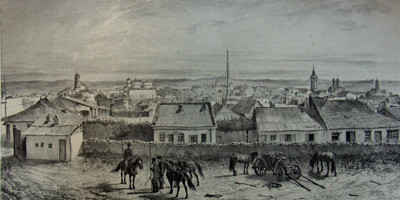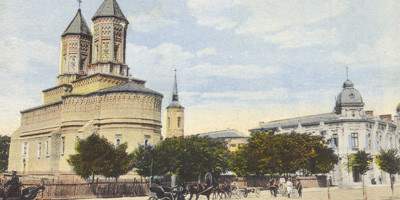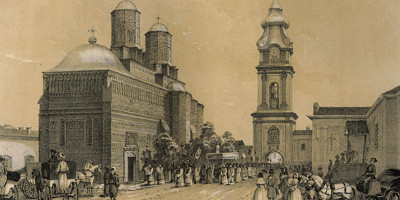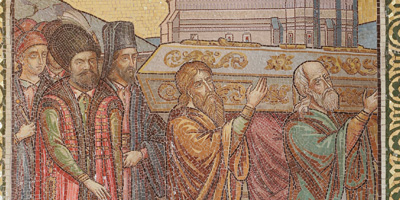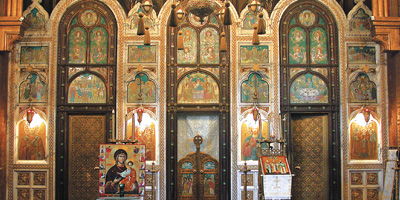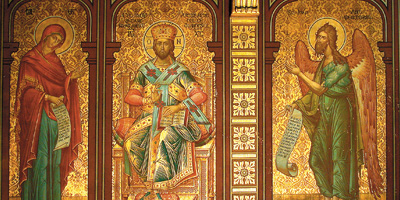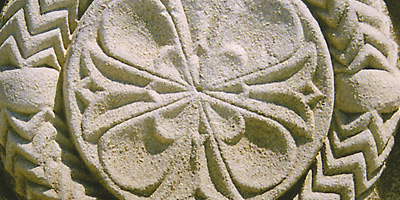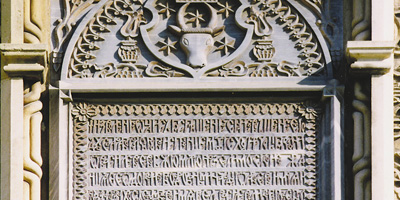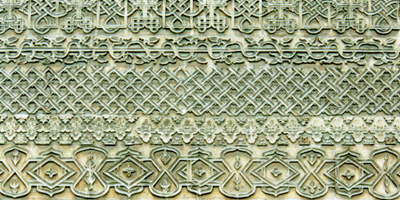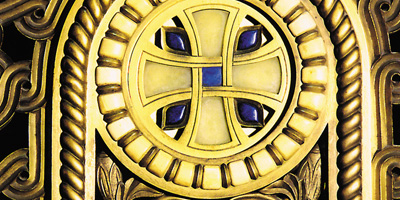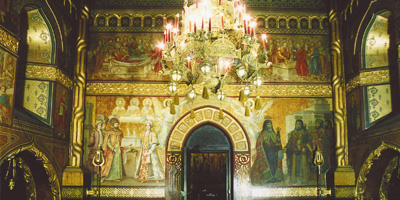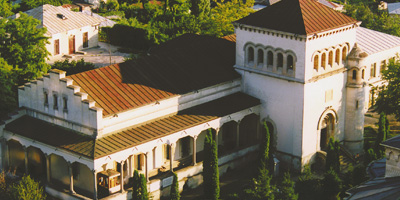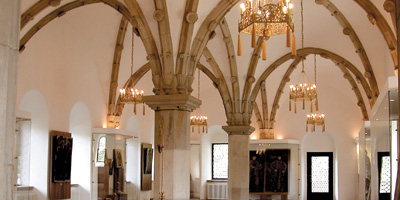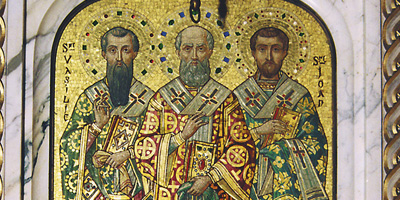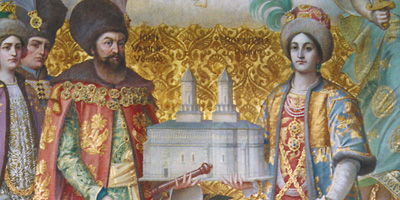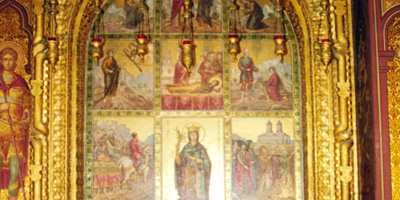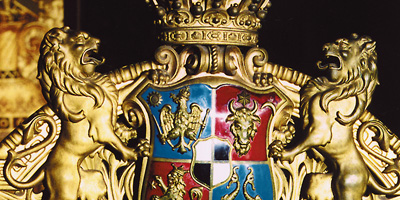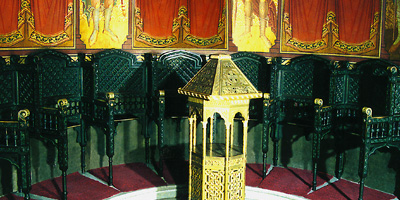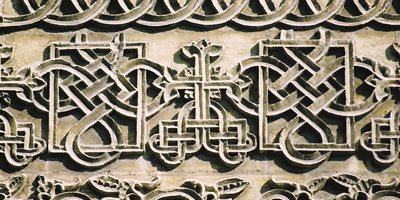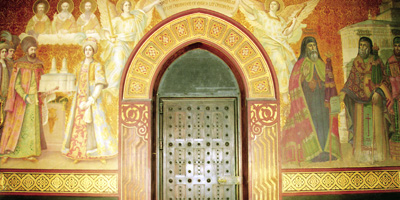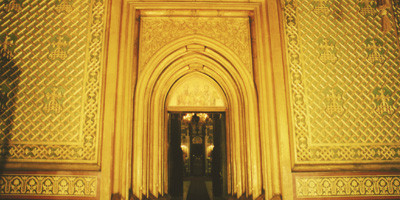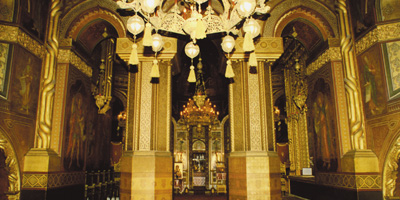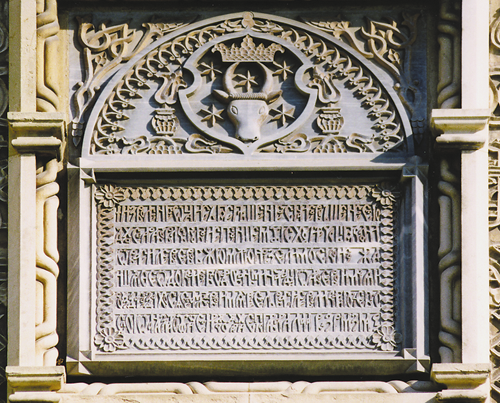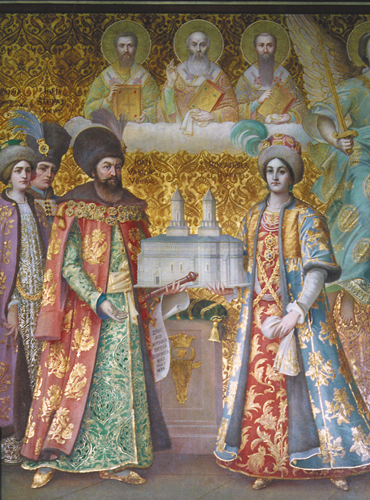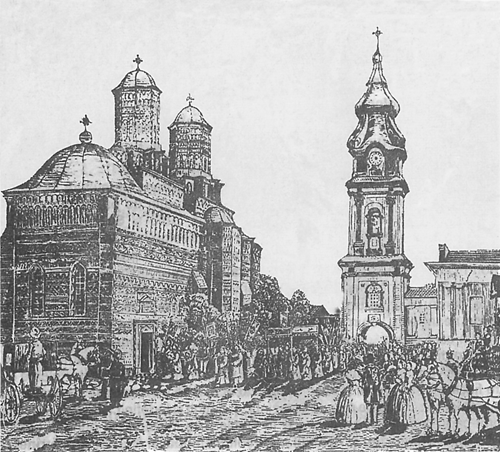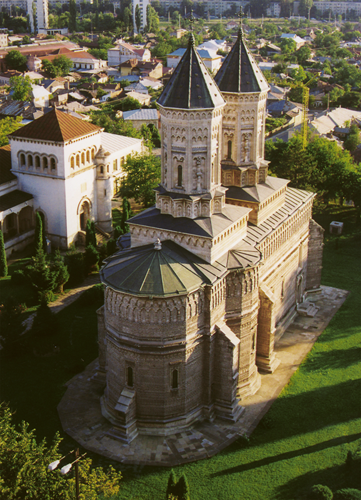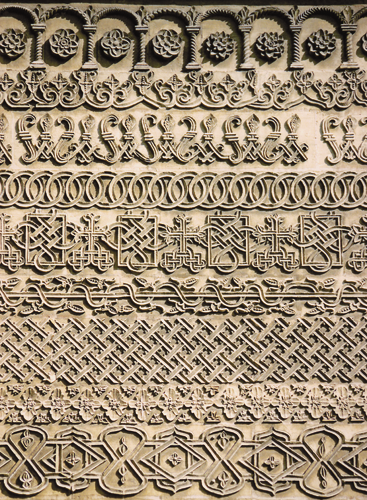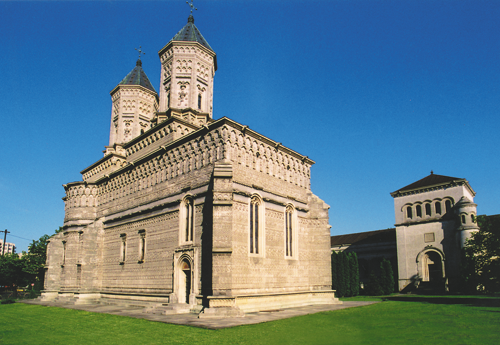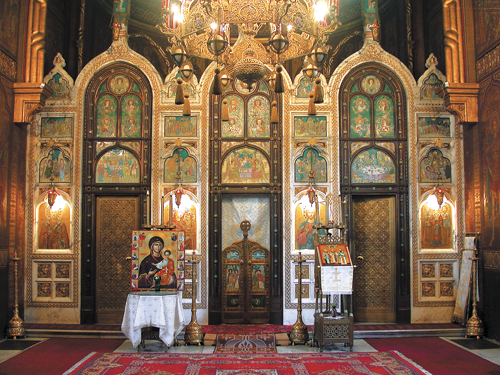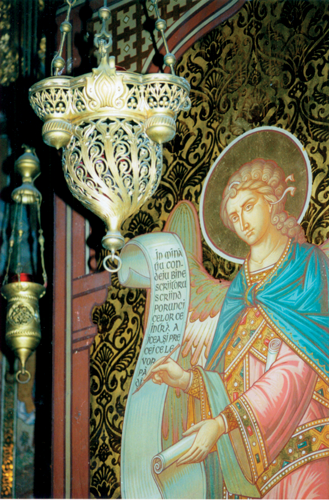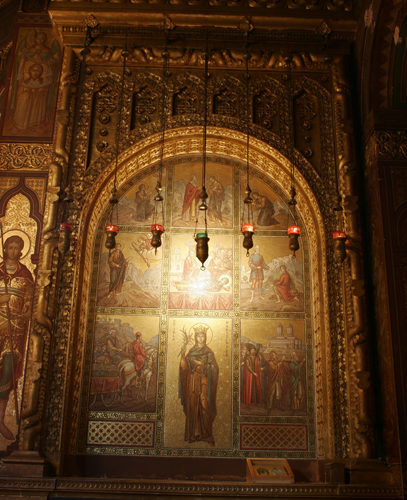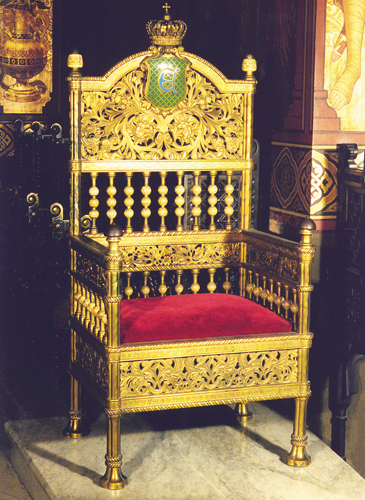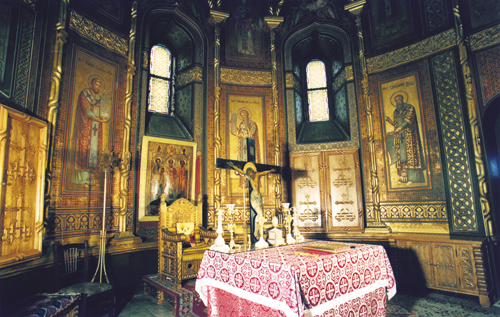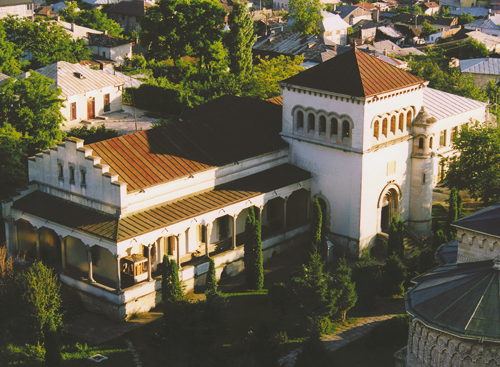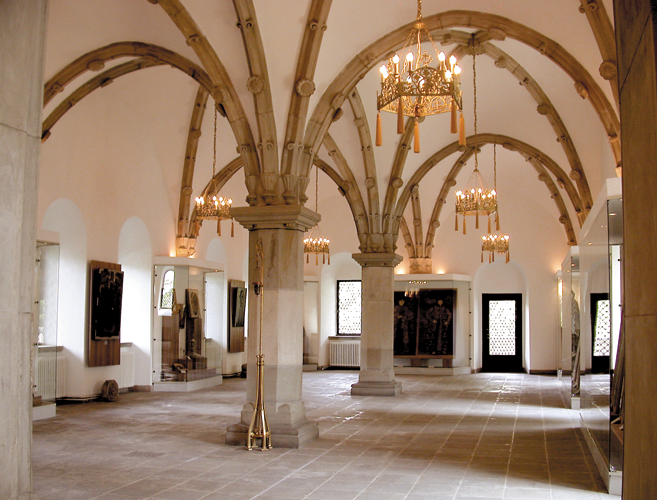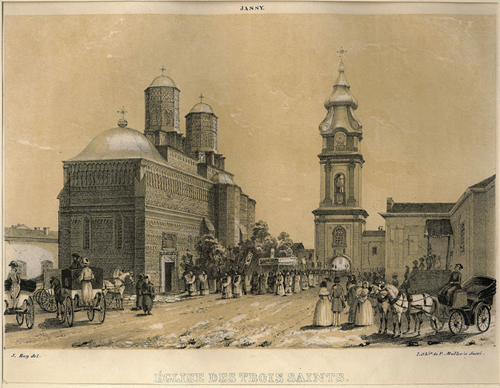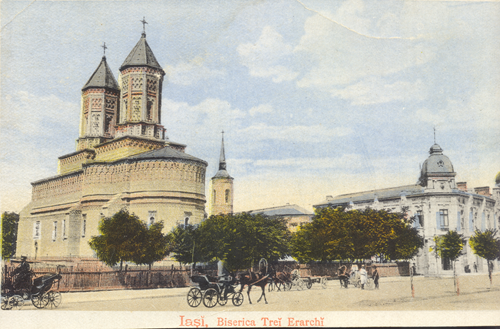■ The Three Holy Hierarchs Monastery - A glimpse on its history
In 1634, following a long series of unhappy reigns and dramatic events, vornic Vasile Lupu acceded to the throne of Moldavia; he was a wise and enlightened boyar who loved beauty and especially faith. During his rule (1634-1653) Moldavia’s
history registered its first cultural thrive. Following the tradition of the great princes of the Musat dinasty, Vasile Lupu began his reign by building a church that was to be unique: "The Three Holy Hierarchs" or the
"Trisfetite" of Iasi.
Above the door of the southern entrance one can read the votive inscription of the founder, Vasile Lupu: "By the will of the Father, with the help of the Son and with the partaking of the Holy Spirit, I, the servant of our Lord and God and Saviour Jesus Christ, and worshipper of the Holy Trinity, Prince Vasile, by the mercy of God ruler of Moldavia, together with Lady Tudosca and with our children - given by God - Prince Ioan, Princess Maria and Princess Rucsandra, have built this holy prayer in the name of the Three Holy Hierarchs, St. Basil the Great, St. Gregory the Theologian and St. John Chrysostom. And it was consecrated by Archbishop Varlaam’s hand on the 6th of May 7147."
Plundered and burned by invaders coming from the East (1650) and from the North (1686), damaged by earthquakes (1711, 1781, 1795, 1802), the church waited for the Independence War (1877) to get over with this succession of humiliating situations.
The restoration of the architectural structure lasted from 1882 to 1887 while the paintings and the inside renovation until 1898; the church was consecrated once again in 1904, during the reign of King Carol I of Romania. The building
that hosts the Gothic Hall was erected by Vasile Lupu; it was restored several times, the last one in 1960.
A feast of arts, the church of the Trisfetite is an authentic cultural and spiritual centre. Iasi received with devoutness Saint Paraskeve’s relics in 1641; this church was the place where the Synod adopted in 1642 the famous Confession of
Orthodox Faith written by Metropolitan Petru Movila, whereas in 1645 the same church witnessed the anointment of the Patriarch of Jerusalem.
Most of the interior elements, commissioned in Vienna and Paris between 1889 and 1890, were offered by King Carol I and Queen Elizabeth. The princely chairs and the archbishop’s, the pews etc. made in gold plated bronze with enamel and ivory
insertions replace the former exotic wooden pieces sculptured in Istanbul. The present-day chandeliers are also made of golden bronze, decorated with ostrich eggs; they replace the old ones that were made of silver but disappeared before
the restoration works.
Vasile Lupu’s "Schola Basiliana" (1640), the future Princely Academy, as well as the printing press that was installed here and which produced in 1643 "The Romanian Book of Teachings" (Varlaam’s Homiliary) are aspects that give the Three Hierarchs
(besides the name of "Monastery of the Patriarchs") the name of "Monastery of the Teachers", this name being also confirmed by the history of the Romanian education in the 18th century. Fulfilling the universal vocation of the
Orthodox Church, this centre of Romanian spirituality was to be the starting point of the Greek Independence War (1821).
The first signal for the liberation of Greece was given in the monastery’s premises by Alexander Ypsilanti who read a proclamation (28th of February 1821) stating the objectives of the Filiki Eteria in the war to free the Balkan
peoples.
The church reopened in July 1994 as a monastery with communal life and daily services.
■ The Three Holy Hierarchs Monastery - Presentation
The Three Holy Hierarchs (St. Basil the Great, St. Gregory the Theologian and St. John Chrysostom) Monastery was designed as a traditional monastic settlement and it is one of the most famous complexes of Romanian Medieval
art, a legendary architectural masterpiece that has never ceased to enchant visitors from all over the world. Its current appearance is the result of the restoration works that took place from 1882 to 1904 under the supervision of
the French architect André Lecomte de Noüy.
The restorations works preserved the outside structure, which has ensured the uniqueness of this monastery among other illustrative monuments of Romanian ecclesiastical architecture. Many significant changes were made during restoration,
both in the church and the adjacent buildings, yet they did not affect the initial architectural design, nor the stone embroidery of the façades. The painting of this holy place, as well as the entire interior decoration, date back
to the same period of the last restoration. The furniture, commissioned by King Charles I and Queen Elizabeth, the new founders of the church, was designed by the same French architect and made in Vienna.
The Outside of the Church
A magnificent stone embroidery covers the outer church in its entirety. It is made up of individually minutely carved blocks of stone, joined together by molten lead, in a wonderful harmony of completely different styles. Under different
circumstances, this style that borrows Caucasian, Byzantine, Gothic and baroque elements could have produced an artistic failure; here, instead, it gave birth to a notable identity, a real masterpiece, The Three Hierarchs Monastery.
The exterior ornaments (originally gold plated) cover the church completely and they combine Turkish, Arabic, Georgian, Armenian and Persian elements with Romanian architectural patterns in a spectacular stone embroidery. More than thirty
strips of ornamental patterns adorn the church from bottom to the top of the spires, and none of them occurs twice.
Persian vases, framed by Russian pilasters, solar disks resembling those sculptured on the Maramures gates, exotic flower patterns, and universal mystical symbols combine in perfect harmony with elements inspired from the traditional Romanian
sculpture, folk embroidery and wood carvings.
The Inside of the Church
The plan of the Three Hierarchs Monastery is typical for 17th century Moldavian churches, and it comprises the porch, the narthex, the nave and the altar. The church has two towers, one above the nave and the other above the
narthex.
The porch has two entrances, one to the north and the other to the south, and is overhung by two small vaults. Access to the narthex is made through a portal-like door, surrounded by five Gothic-looking mouldings and two rectangular frames.
The bronze door features the twelve Apostles in bas-relief. Above the door there is the icon of the Three Holy Hierarchs, made of gold plated mosaic.
In the original architecture, the narthex was separated from the nave by a massive wall, replaced during the restoration works by three arcades supported by two pillars. One should notice that the angles of the narthex walls as well as
the angles between the walls and the vaults are closed by the same ornamental twisted band to be found in the external decoration. The lateral walls of the narthex shelter four tombs, two on each side, dug as vault-like niches. Here
lie the remains of the founders’ family as well as those of Prince Dimitrie Cantemir and of Prince Alexandru Ioan Cuza. The tombs are covered by massive tombstones of decorated black marble.
The relics of Saint Paraskeve, given to Prince Vasile Lupu for his generous help to the Ecumenical Patriarchate, were brought from Constantinople and put in a niche that had been created especially for this purpose; this
niche is decorated with marble, precious stones and mosaics that illustrate the Saint’s life.
Nowadays, St. Paraskeve’s relics can be worshipped in the Metropolitan Cathedral of Iasi, while the niche in the church of the Three Hierarchs shelters St. Basil the Great’s relics, offered as a gift to Prince Vasile Lupu in 1650. Seized
by the communist officials in 1975, the relics of the great hierarch were returned to the town of Iasi on the 28th of December 2000.
The iconostasis of the church dates back to the end of the 19thp century, when the old one, that had been severely deteriorated, had to be replaced. The new iconostasis was sculptured in Carrara marble and decorated with mosaics
and enamels. The votive candles, the candlesticks as well as the other pieces of furniture date back to the same period of the last restoration and were made of bronze studded with ivory and precious stones.
The altar has two spacious niches: the proskomid niche and the vestry, and it fits the architectural design of the church. The walls are decorated with the icons of the Three Holy Hierarchs, framed by cable columns.
■ The Three Holy Hierarchs Monastery - The Museum
Next to the church lies a building that houses a museum of religious art, where one can admire, among other things, objects related to the history of the Three Hierarchs Monastery. This building is also known as the Gothic Hall,
and from the very beginning, it had an unusual story: it served as a refectory for the Three Holy Hierarchs Monastery (1635-1639), as well as a chapel (19th century).
The name "Gothic" is justified not by its external architecture, but by its interior ogival vaults framed by stone ribs. This adjacent building is also remarkable for its outside balcony with 12 cylinder-like stone columns
and a Roman tower at the entrance built during the general restoration of the monastery (1890), which was meant to replace the high bell tower that had been demolished. The current appearance of the church is due to the 1960 restoration
works. The west wing of the building accommodates the Elder’s office and a few cells.
The cells of the Three Hierarchs Monastery have witnessed many crucial events for the Romanian education and culture. The first printing press in Moldavia was set up here in 1640; it was used for printing the Romanian Cazania (Homiliary) by Metropolitan Varlaam,
his comprehensive treatise on The Seven Sacraments of the Church, the Answer to Calvin’s Catechism, as well as Vasile Lupu’s Pravila (Law Code), the first Moldavian law anthology.
During the same period of time, Prince Vasile Lupu laid the foundation of the "Schola Basiliana", the very first Romanian educational institution in Moldavia, organized according to the model of the Kiev Academy. By the
end of the 19th century, the "Schola Basiliana" was still functioning in the cells of the Three Hierarchs Monastery, under the name of Vasile Lupu Preparatory School (for the education of schoolmasters).
In 1874, the great Romanian poet Mihai Eminescu was a member of the examining jury of this school; he lived for a while in one of the Monastery’s cells.
Beyond the main goal for which it had been built, the Gothic Hall reminds us of at least two crucial events in the history of the Monastery. First of all, it is here that in 1642 took place the pan-Orthodox theological debates that were
concluded by the adoption of the Confession of Orthodox Faith written by Petru Movila, Metropolitan of Kiev. This event was recorded in history under the name of the Synod of Iasi. Two centuries later, in 1888, the chapel situated
in the Gothic Hall, temporarily hosting Saint Paraskeve’s reliquary, witnessed the most amazing and best-known miracle worked by the Saint: her relics remained untouched by the great fire that wrought havoc during the night of December
26/December 27, although everything else around burned down.
For decades, the Gothic Hall has been housing objects pertaining to our historical and ecclesiastical patrimony, and since the 15th of October 2001, it has been welcoming its visitors with a new appearance and
a new organisation of the items on display, as the old collection was completed with other pieces, recently brought.
Obviously, the most valuable objects are those directly related to the Three Holy Hierarchs church during the rule of Vasile Lupu, its founder (1635-1653).
Thus, fresco fragments from the original painting made by Russian icon painters show the exquisite artistic sensitivity with which the church was painted. Impressed with it, an observer of the time is recorded to have said: "such miniature painting, done with so much charm, as that on the arches and the arcades of the two vaults of this church, I have not seen in any other country so far" (Evlia Celebi, Turkish voyager).
One of the most valuable paintings is the votive painting representing Vasile Lupu and his family. The Royal Icon of the Three Holy Hierarchs is a singular proof of the beauty of the iconostasis made in Moskow in 1639. Other precious
objects that illustrate Vasile Lupu’s time are the remarkable embroidered epitaphions representing Lady Tudosca, the Prince’s spouse, and their son, Prince Ioan. These pieces of artistic work have been traditionally attributed to Lady
Tudosca herself. An embroidered epitrachelion and two cups made of gold plated silver are among the objects offered by the founder Vasile Lupu to his church. The collection of the museum could not be complete without a copy of the
first book in Moldavia printed in Romanian, the Cazania (Homiliary) of Varlaam, Metropolitan of Moldavia, a linguistic monument that was printed in the cells of the Monastery (1643).
The Gothic Hall museum is dedicated to the art and ecclesiastical history in the 17th and 19th century Moldavia, and it aims to be a living place that could help us better understand our national
the past. It hosts temporary exhibits and it invites visitors to enter a space where the mystery of the past reveals itself and gives them the key to a future when beauty could save the world.
